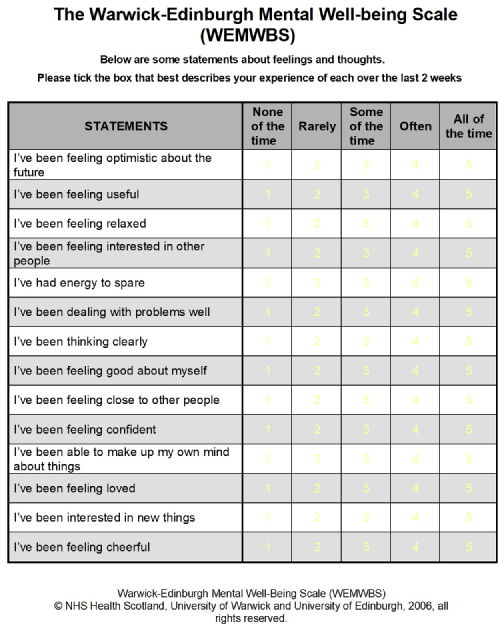WEMWBS: 14-item vs 7-item scale
There are two versions of the Warwick-Edinburgh Mental Wellbeing Scale. Both scales are considered to be robust and valid when applied in population, community, educational, occupational and clinical settings. The choice you make will depend on your study needs.
14-item scale WEMWBS
- This is the original WEMWBS. It provides a fuller picture of mental wellbeing with a better balance of feeling and functioning items than the 7-item scale WEMWBS. It is preferred in situations where it is valuable to give study participants a picture of their mental wellbeing.
- The majority of validation studies and translations have been carried out using the full scale. See Validation and psychometric properties.
- WEMWBS has been shown to be 'responsive to change' (meaning: it can detect improvement or deterioration in many different situations) at both group and individual level.
- At individual level 'minimum detectable change' has been calculated using different recommended methods giving results of 3 and 8 points. A change of 3 points means that scores on three items have improved or worsened by 1 point, or scores on one item have improved or worsened by 3 points. This suggests that the lower threshold of 3 points can be taken to represent 'meaningful change' between measurement points in individuals.
7-item scale WEMWBS
- This is shorter than the 14-item scale WEMWBS and so can save valuable space and time in evaluations.
- It has a preponderance of functioning items.
- It has better scaling properties which means that the measurement of differences in scores may be more precise.
- It has been shown to be 'responsive to change' in clinical populations undergoing psychotherapy at both group and individual level.
- Total scores need transforming (table provided).
- At the individual level, using different recommended methods 'minimal detectable change' is calculated as 1 or 3 points.


